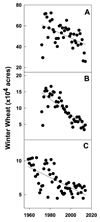Global solutions to regional problems: Collecting global expertise to address the problem of harmful cyanobacterial blooms. A Lake Erie case study
- PMID: 28073479
- PMCID: PMC5230759
- DOI: 10.1016/j.hal.2016.01.003
Global solutions to regional problems: Collecting global expertise to address the problem of harmful cyanobacterial blooms. A Lake Erie case study
Abstract
In early August 2014, the municipality of Toledo, OH (USA) issued a 'do not drink' advisory on their water supply directly affecting over 400,000 residential customers and hundreds of businesses (Wilson, 2014). This order was attributable to levels of microcystin, a potent liver toxin, which rose to 2.5μgL-1 in finished drinking water. The Toledo crisis afforded an opportunity to bring together scientists from around the world to share ideas regarding factors that contribute to bloom formation and toxigenicity, bloom and toxin detection as well as prevention and remediation of bloom events. These discussions took place at an NSF- and NOAA-sponsored workshop at Bowling Green State University on April 13 and 14, 2015. In all, more than 100 attendees from six countries and 15 US states gathered together to share their perspectives. The purpose of this review is to present the consensus summary of these issues that emerged from discussions at the Workshop. As additional reports in this special issue provide detailed reviews on many major CHAB species, this paper focuses on the general themes common to all blooms, such as bloom detection, modeling, nutrient loading, and strategies to reduce nutrients.
Keywords: CHAB; Cyanobacteria; Lake Erie; Microcystin; Nitrogen; Phosphorus.
Copyright © 2016 Elsevier B.V. All rights reserved.
Figures








References
-
- Akhurst D, Jones GB, McConchie DM. The application of sediment capping agents on phosphorus speciation and mobility in a sub-tropical dunal lake. Marine and Freshwater Research. 2004;55:715–725.
-
- Ali KA, Ortiz JD. Multivariate approach for chlorophyll-a and suspended matter retrievals in Case II waters using hyperspectral data. Hydrological Sciences Journal. 2014;59:1–14. doi: 10.1080/02626667.2014.964242. - DOI
-
- Ali KA, Witter DL, Ortiz JD. Multivariate approach to estimate color producing agents in Case 2 waters using first-derivative spectrophotometer data. Geocarto International. 2014a;29(2):102–127. doi: 10.1080/10106049.2012.743601. - DOI
-
- Ali KA, Witter DL, Ortiz JD. Application of empirical and semi-analytical algorithms to MERIS data for estimating chlorophyll a in case waters of Lake Erie. Environmental Earth Sciences. 2014b;71(9):4209–4220. doi: 10.1007/s12665-013-2814-0. - DOI
-
- Allen BL, Mallarino AP, Klatt JG, Baker JL, Camara M. Soil and surface runoff phosphorus relationships for five typical USA midwestern soils. Journal of Environmental Quality. 2006;35:599–610. - PubMed
Publication types
MeSH terms
Grants and funding
LinkOut - more resources
Full Text Sources
Other Literature Sources
Research Materials
Miscellaneous

